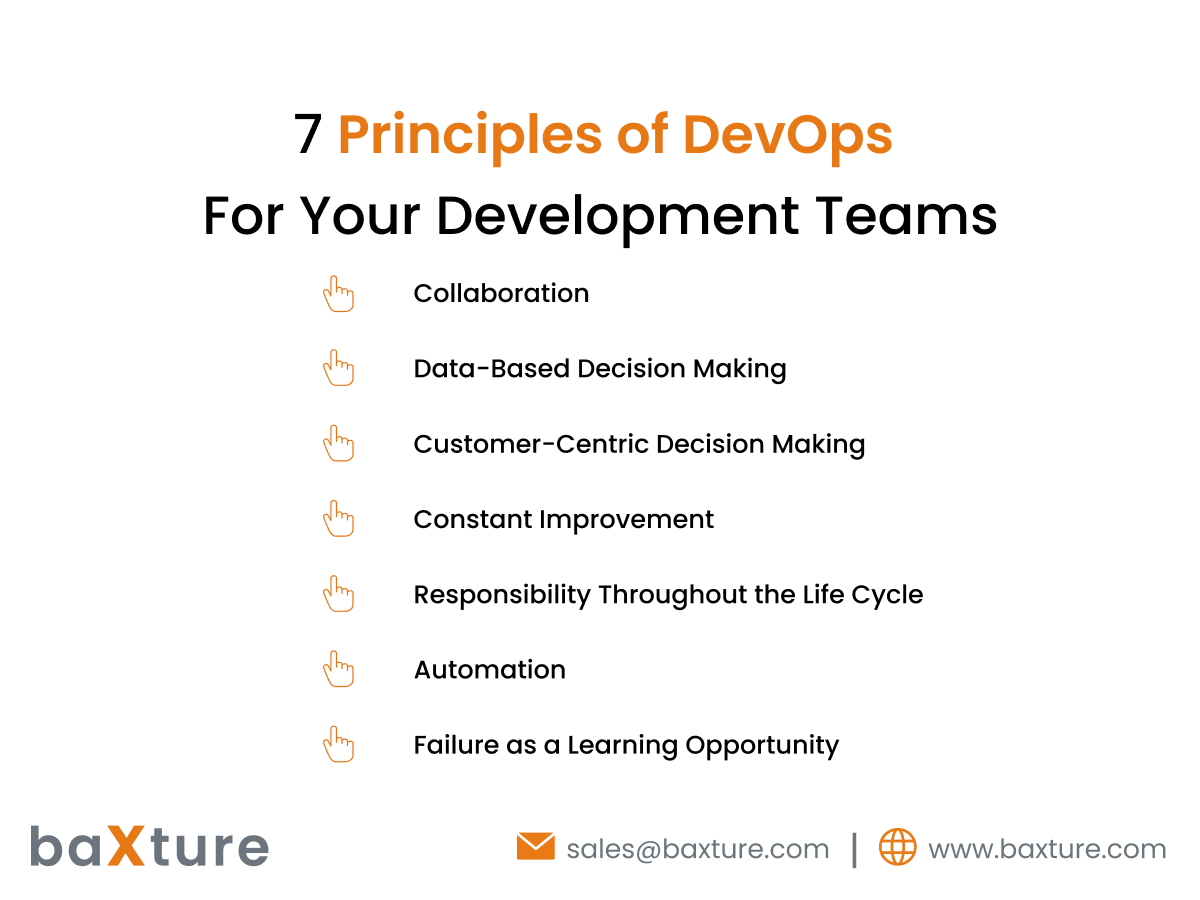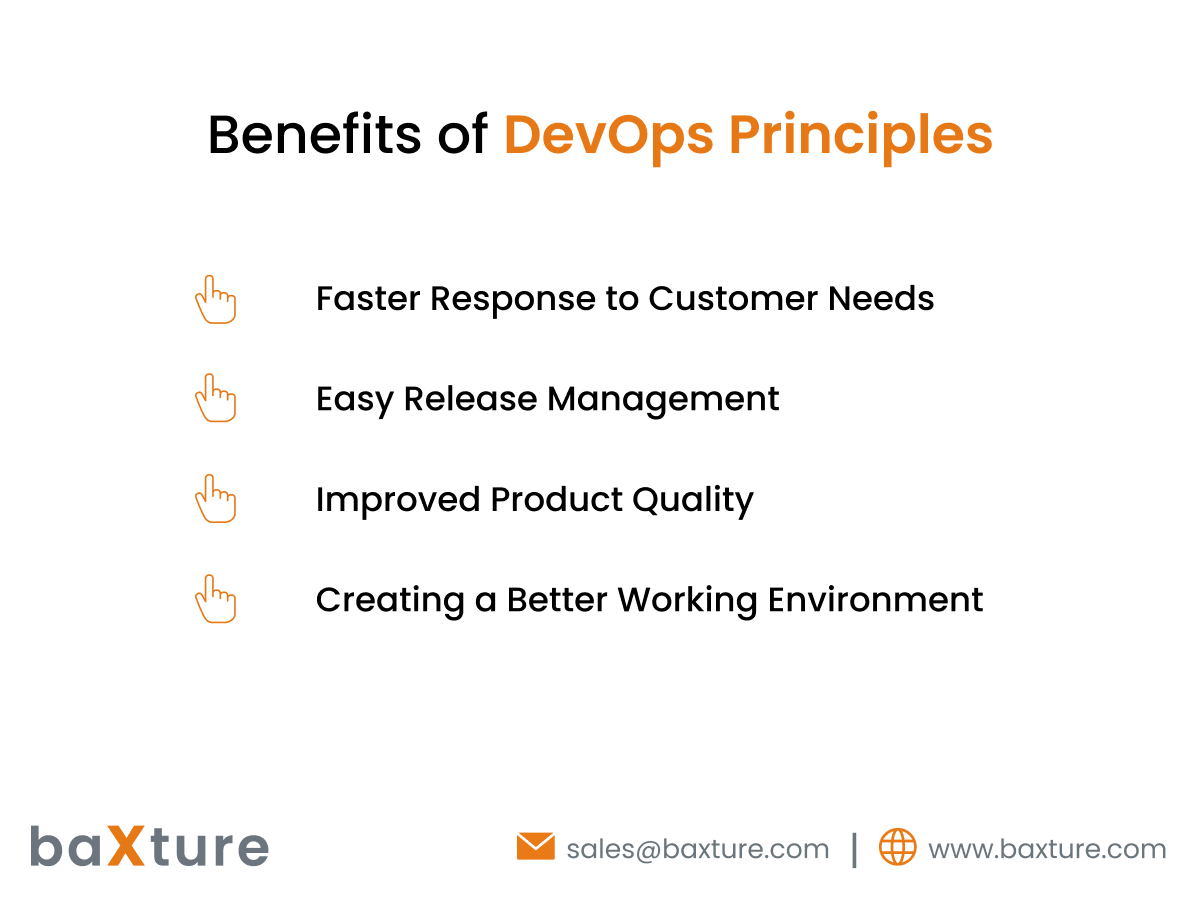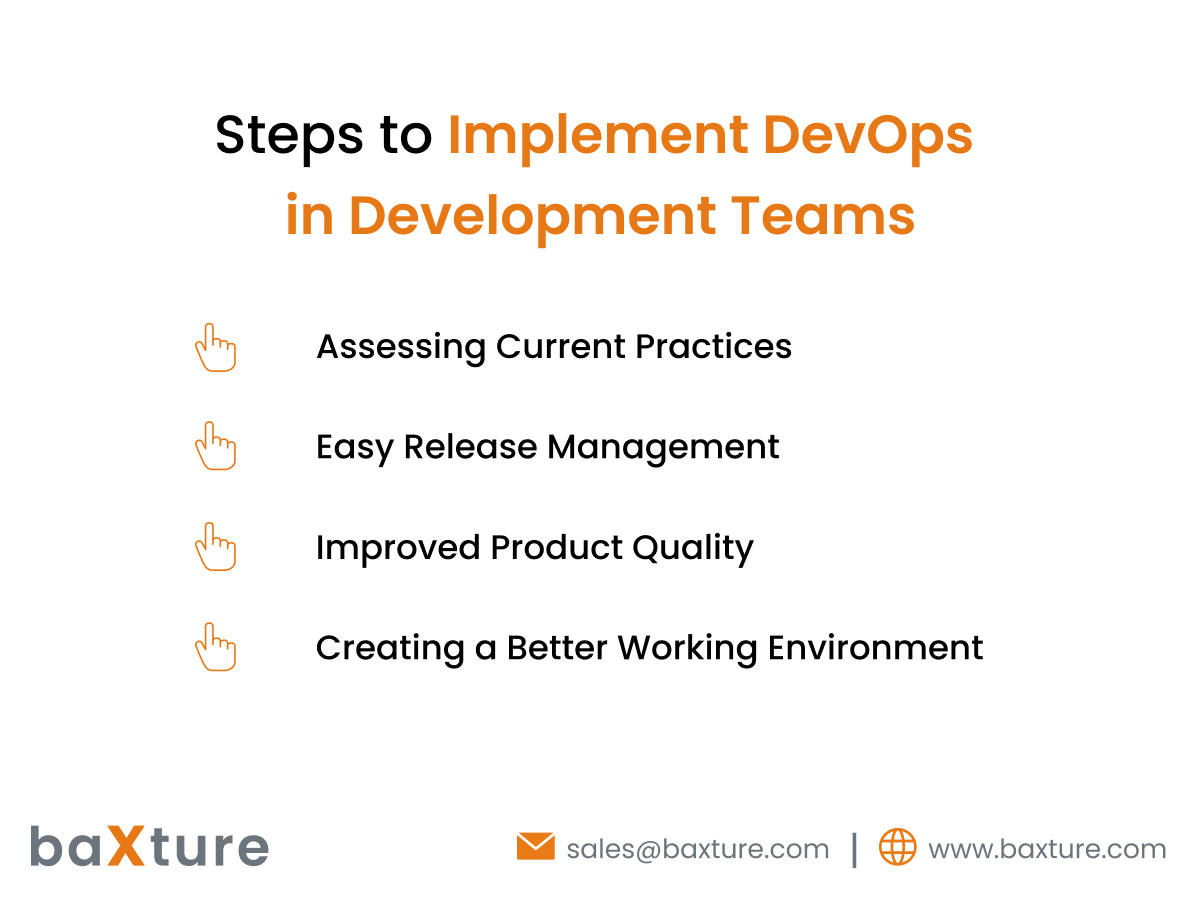Blogs
7 Principles of DevOps for Your Development Teams

DevOps Overview
DevOps stands as a transformative force. Short for Development and Operations, it embodies collaborative practices and cultural philosophies. DevOps aims to streamline the intricate software development and deployment process, unifying development and IT operations in a culture of innovation, automation, and constant enhancement.
This concept bridges the gap between development and operations, fostering collaboration while infusing automation for efficiency. Beyond methodologies, DevOps is a mindset that thrives on continuous improvement. It reshapes software development into a process that not only meets the digital era's demands but propels organizations toward excellence.
Join us as we explore the eight key principles of DevOps, the building blocks for successful development teams. Dive into this philosophy that redefines software and app development, positioning your organization for success in an era where innovation reigns supreme. Welcome to the world of DevOps, where collaboration, automation, and relentless improvement unite for a brighter future in software development.
7 Must-Know DevOps Principles

1. Collaboration
Collaboration is at the heart of DevOps. It involves breaking down traditional silos between development, operations, and other relevant teams. In a collaborative DevOps environment, cross-functional teams come together seamlessly. Developers, operations engineers, quality assurance professionals, and even business stakeholders work as a cohesive unit. This synergy enables them to share knowledge, skills, and responsibilities. Collaborative DevOps teams are empowered to jointly tackle complex challenges, leading to faster problem-solving and more efficient workflows.
2. Data-Based Decision Making
In DevOps, data is a valuable asset that drives informed decision-making. Organizations collect and analyze data from various sources within the software development and deployment lifecycle. This data includes metrics related to code quality, deployment frequency, and system performance. By harnessing the power of data analytics, DevOps teams gain valuable insights into their processes. They can identify trends, bottlenecks, and areas for improvement. These data-driven decisions empower teams to optimize workflows, enhance product quality, and meet customer expectations more effectively.
3. Customer-Centric Decision Making
DevOps places a strong emphasis on customer satisfaction. This principle ensures that every decision and development effort centers around meeting customer needs. To achieve this, organizations establish continuous feedback loops with their customers. They actively seek input and consider customer preferences during product development. User-centric design practices are also integrated into the development process, ensuring that the final product aligns with customer expectations. Customer-centric decision making ultimately leads to the delivery of products and services that resonate with and delight users.
4. Constant Improvement
DevOps embraces a culture of perpetual advancement. Team members are encouraged to consistently seek opportunities to enhance processes and deliver greater value. This culture promotes a mindset of experimentation and innovation. DevOps teams regularly review their workflows, tools, and methodologies. They identify areas where improvements can be made, whether through adopting new technologies, streamlining processes, or refining development practices. Continuous improvement ensures that organizations remain agile and responsive in a rapidly evolving technological landscape.
5. Responsibility Throughout the Life Cycle
DevOps principles advocate for end-to-end responsibility across the software development life cycle. This means that every team member takes ownership of their work from inception through production deployment. By minimizing handoffs and delays, DevOps teams ensure that accountability is maintained at every stage. Developers are responsible not only for coding but also for ensuring that their code functions as expected in a production environment. Operations engineers collaborate closely with developers to facilitate smooth deployments and maintenance. This end-to-end responsibility enhances the reliability and speed of software delivery.
6. Automation
Automation is a fundamental pillar of DevOps. It involves the systematic use of tools and practices to reduce manual intervention, minimize errors, and expedite the delivery pipeline. Automated testing, for example, allows for swift and consistent evaluation of code changes, significantly reducing the risk of introducing defects. Deployment pipelines are automated to ensure that code moves seamlessly from development to production environments. Automation not only accelerates the delivery of software but also enhances consistency and repeatability, making it a cornerstone of DevOps success.
7. Failure as a Learning Opportunity
In DevOps, failure is not viewed as a setback but as a valuable learning opportunity. This mindset shift fosters a culture of experimentation and resilience. When something goes wrong, DevOps teams engage in post-mortem analyses to understand the root causes of failures. They share these lessons learned across the organization, ensuring that mistakes are not repeated. This approach not only encourages innovation but also builds a robust foundation for continuous improvement. By embracing failure as a stepping stone to growth, DevOps teams adapt, innovate, and evolve to deliver better solutions to their customers.
The DevOps Culture
Building a DevOps Culture
Creating a DevOps culture is not just about following practices; it's about instilling the right mindset and values within your team:
Constant Communication and Collaboration
Building a DevOps culture starts with breaking down communication barriers. DevOps emphasizes collaboration between traditionally siloed teams, such as development, operations, and quality assurance. Open communication channels enable teams to share knowledge, insights, and challenges in real time. This spirit of cooperation fosters a sense of shared responsibility, where everyone is working towards a common goal—the successful delivery of valuable software to the customer.
Gradual Changes for Stability
One of the core tenets of DevOps is the idea of delivering small, incremental changes rather than large, disruptive ones. This approach reduces the risk of system failures and disruptions. Teams should adopt practices like continuous integration and continuous deployment (CI/CD) to automate the process of delivering changes in a controlled and predictable manner. By gradually introducing changes, organizations ensure that system stability is maintained, and issues can be addressed promptly.
Sharing End-to-End Responsibility
In a DevOps culture, every team member understands that they have a vital role to play in delivering value to the customer. This goes beyond traditional job roles and titles. Developers, operations engineers, testers, and business stakeholders all share the responsibility for the success of the product or service. This shared ownership fosters a sense of accountability and encourages individuals to proactively contribute to the overall success of the project.
Early Problem Solving for Efficiency
DevOps encourages teams to identify and address issues as early as possible in the development process. This proactive approach minimizes the chances of defects or problems making their way into production. Teams should implement practices such as automated testing and continuous monitoring to detect and resolve issues in real time. By addressing problems early, organizations not only streamline workflows but also reduce the time and effort required for troubleshooting and bug fixing in later stages of development.
Benefits of DevOps Principles

DevOps principles bring substantial advantages to software development services:
Faster Response to Customer Needs
DevOps principles enable organizations to respond rapidly to changing customer needs and market demands. By fostering a culture of continuous integration and continuous deployment (CI/CD), teams can develop and deliver software updates more quickly. This agility ensures that the software remains relevant in a competitive landscape. DevOps practices such as automated testing and deployment pipelines allow for efficient and reliable delivery of features and enhancements, meeting customer expectations faster.
Easy Release Management
DevOps streamlines the release management process. Automated deployment pipelines, version control, and infrastructure as code (IaC) enable organizations to release software updates and new features with ease. This reduces downtime and minimizes the risk of deployment failures. DevOps also encourages smaller, incremental releases, allowing for a more frequent release cadence. This frequent release cycle not only keeps the software up-to-date but also ensures that customers receive valuable improvements more regularly.
Improved Product Quality
DevOps emphasizes continuous testing and monitoring throughout the software development life cycle. Automated testing ensures that code changes are thoroughly checked for bugs and regressions. Continuous monitoring of applications in production identifies issues in real-time, enabling proactive resolution. Additionally, feedback loops between development and operations teams help pinpoint areas for improvement. This relentless focus on quality leads to a more robust and reliable product, reducing the likelihood of post-release issues.
Creating a Better Working Environment
DevOps not only improves technical processes but also transforms the work environment. Collaboration between development, operations, and other teams promotes a sense of shared responsibility and ownership. This collaborative culture enhances team morale and encourages individuals to contribute their expertise to the collective goal. Furthermore, DevOps values innovation and encourages experimentation. Teams are empowered to find creative solutions to challenges, fostering an innovative and dynamic work culture. The result is a more motivated and productive workforce.
Why Does DevOps Recommend Shift Left Testing Principles?
Exploring the Importance of Shift Left Testing
Shift Left Testing is a practice that involves moving testing activities earlier in the software development cycle, aligning with DevOps principles: Shift Left Testing is a critical practice in modern software development that emphasizes moving testing activities closer to the beginning of the development process. Traditionally, testing occurred late in the cycle, often leading to costly defects and release delays. However, by shifting testing activities to the left, teams can identify and address issues earlier in the development cycle. This practice aligns perfectly with DevOps principles, where speed, collaboration, and continuous improvement are paramount.
How Shift Left Testing Aligns with DevOps Principles
Discover how Shift Left Testing seamlessly integrates with the DevOps approach, catching issues earlier and reducing release delays: Shift Left Testing aligns with key DevOps principles in several ways:
Continuous Integration (CI): Shift Left Testing fits naturally within CI pipelines. Automated tests are integrated early, ensuring that code changes are rigorously tested with every commit. This prevents the introduction of defects and promotes rapid feedback.
Collaboration: Shift Left Testing encourages collaboration between developers, testers, and other stakeholders from the project's outset. This collaborative approach ensures that quality considerations are integrated into the development process.
Automation: DevOps heavily relies on automation, and Shift Left Testing is no exception. Automated testing tools and scripts are used to conduct tests consistently and efficiently, reducing the need for manual testing efforts.
Feedback Loops: Early testing provides valuable feedback to developers, enabling them to rectify issues quickly. This aligns with DevOps' focus on feedback loops, where continuous improvement is driven by timely insights.
Real-World Examples and Case Studies
Explore real-life examples of organizations that have successfully adopted Shift Left Testing within their DevOps workflows, showcasing the benefits of this approach:
Netflix: Netflix is known for its high-quality streaming service. They have implemented Shift Left Testing by integrating automated testing into their CI/CD pipelines. This approach allows them to identify and address issues before they reach production, ensuring a seamless viewing experience for their customers.
Etsy: Etsy, an e-commerce platform, has embraced Shift Left Testing to enhance the quality of their website. By catching bugs early in the development process, they have reduced the time and cost associated with bug fixing. This approach aligns with Etsy's commitment to providing a smooth shopping experience for their users.
Amazon: Amazon, a pioneer in e-commerce and cloud computing, has integrated Shift Left Testing practices into their development cycles. This has helped them maintain a high level of reliability and performance for their services, aligning with their customer-centric approach.
Implementing DevOps Principles

Steps to Implement DevOps in Development Teams
Assessing Current Practices
Evaluate your current processes, identifying areas that need improvement: The first step in implementing DevOps is to conduct a thorough assessment of your existing development and operations practices. This involves examining workflows, tools, and communication processes within your organization. Identify bottlenecks, pain points, and areas where manual intervention is prevalent. By understanding your current state, you can pinpoint the specific challenges that DevOps can address and tailor your approach accordingly.
Setting Clear Goals
Define clear, measurable objectives for your DevOps journey: Before diving into DevOps practices, it's crucial to establish clear and achievable goals. These goals should be specific, measurable, attainable, relevant, and time-bound (SMART). Examples of DevOps goals may include reducing deployment time, increasing deployment frequency, or improving overall system reliability. Having well-defined objectives provides a roadmap for your DevOps implementation and helps align your team's efforts.
Building the Right Skill Set
Invest in training and skill development to equip your team with the necessary expertise: DevOps requires a diverse skill set that spans development, operations, automation, and more. Invest in training and skill development programs for your team members to ensure they have the expertise needed for successful DevOps implementation. This may involve learning new tools, adopting coding practices, or enhancing soft skills related to collaboration and communication. Well-trained teams are better equipped to embrace DevOps principles effectively.
Selecting DevOps Tools and Technologies
Carefully choose tools and technologies that align with your goals and workflows: DevOps relies on a variety of tools and technologies to automate and streamline processes. Carefully evaluate and select the tools that align with your specific DevOps objectives and the technologies you use in your development stack. Common DevOps tool categories include version control systems, continuous integration/continuous deployment (CI/CD) tools, containerization platforms, and monitoring solutions. The right toolset can significantly enhance your team's efficiency and productivity.
Continuous Monitoring and Improvement
Continuously monitor and adjust your DevOps practices for ongoing optimization: DevOps is an evolving journey, not a one-time implementation. Establish a culture of continuous improvement by regularly monitoring key performance indicators (KPIs) and seeking feedback from your team. Analyze the data to identify areas that need adjustment and optimization. This iterative approach allows you to fine-tune your DevOps practices, adapt to changing requirements, and stay aligned with your goals. Continuous improvement ensures that your DevOps implementation remains effective and relevant over time.
Conclusion
DevOps, short for Development and Operations, is a transformative force that embodies a culture of collaboration, innovation, and automation, streamlining the intricate software development and deployment process. It unites development and IT operations, fostering a continuous improvement mindset. Beyond methodologies, DevOps shapes a future where software development meets the digital era's demands and propels organizations toward excellence. As we delve into the eight key DevOps principles, we explore the foundation for successful development teams, navigating the dynamic world of software development.